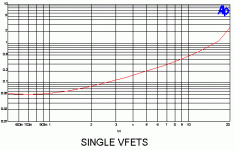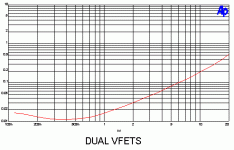no , you aren't
to quote one handsome and overly clever chap :

I will be trying out some of the front end goodies 😛
BDP
... I have a few (4-8) pairs I might offload at cost though ...
Thanks for the intense interest, just to update that the offloading is completed, a few more DIYers are now having the VFETs for this project 🙂
BTW, I would like to sign up for the PCB also, or whatever kit format that it'll come with at the end.
no , you aren't
to quote one handsome and overly clever chap :

nope
however - his Sony amp is Demonstration of Force ( as many other recent pieces are)
for moi - using them as followers = waste of parts - considering that he's able to make the same with plain dirt mosfets
I'm not sure will he admit that , or not
That's an even bigger Quote from other thread.
Does this mean that in this follower configuration the VFETs don't make the sound?
But the new front end is giving this amp it's sonic signature?
But the new front end is giving this amp it's sonic signature?
Last edited:
Here is something similar to the Sony-VFET-2 using IRFP240 and IRFP9240 output devices. The front-end also supports cascode feedback, but has bias circuits more like the F4. I am still "tweaking" its sound.
I like this very much!
Do you have more information, pictures available? Or have you posted it already somewhere?
Does this mean that in this follower configuration the VFETs don't make the sound?
But the new front end is giving this amp it's sonic signature?
Papa wrote in Part 2 "But the big Sony VFET amp project showed that they have something to bring to the table with push-pull topologies as well." Although nothing specific on follower mode....
(BTW not so fun if the same can be done with ordinary MOSFETs 😉 )
Another thing, the voltage gain is developed in stage two with the 2SJ313/2SK2013 MOSFETs. Could not this have been done with JFETs also? Correct me, but I seem to remember Ernö Borbely did something like that with some parallelled 170/74s? But, maybe the MOSFETs simply are better in that position.
Does this mean that in this follower configuration the VFETs don't make the sound?
But the new front end is giving this amp it's sonic signature?
not exactly that VFets (OS) aren't contributing to sound
(with some luck you'll find Papa's THD graps for sole VFets source follower stage ; compare them with , say , F4 THD graphs)
however , same as I am inclined towards blissful ingeniousness and wittiness of M2 (Jfet buffer +xformer+Mosfet source follower) I am more inclined to simple (well known) Mosfet source follower stage than to (preputium made of) already ultra rare Sony Fets in same role ; it's better to use them in common drain config , so having greater character exploitation
( I have some , so I'm not talking here about sour grapes)
Pap's goal is to explore and to present to Greedy Boys ;
but , my own goal wa sand still is to make as many permutations/iterations I can-for learning purposes , but I'll always choose by my own preferences
previous Mithrandir's spells aren't worse than (most) present one

Attachments
Last edited:
I think the new toy Papa gave us is a unique combination of best driver stage and an output stage even his commercials don't have…….
Hope that I am right in the last point, I do not know what his Xs Amps use as Semis.
I think it is a unique chance to build something very fine….
and because M2 is out of production I hope that Mr. Pass will give free sometimes the circuits and we all can share Zen Mods experience too….
🙂🙂🙂
Hope that I am right in the last point, I do not know what his Xs Amps use as Semis.
I think it is a unique chance to build something very fine….
and because M2 is out of production I hope that Mr. Pass will give free sometimes the circuits and we all can share Zen Mods experience too….
🙂🙂🙂
...., I do not know what his Xs Amps use as Semis.
.....
I believe it's already known that Mosfets are in question ?
or I was day-dreaming , as usual .... 😛
edit: 18pcs per quadrant ( means 72pcs/per channel) plus 20pcs per OS SE CS (means 40pcs per channel) , judging by pics around

Last edited:
Am I wrong to assume that there is a great deal in this article that has nothing to do with Vfets?
My first thought was "What a beautiful driver stage, and all my favorite parts are present!"
I presume those are for CCS.yup
M2 having 2N3055+BDX18 in output

is there still no consensus on using a single pair of sits at the output? if the only draw back is less output power then I don't see it as much of an issue for people that want to go ahead and start building... it seems like it negates a lot of problems like matching, etc
It is certainly true that there are interesting things about the front end that
have nothing to do with the VFETs, or for the output stage in general. You
can easily apply this circuit to another follower output stage.
Toshiba Mosfets 2SJ201/2SK1530 or 2SJ618/2SK3497 would make fine
output stages, and lacking those, IRFP240/9240 would work. They would
require matching and some Source resistors, say 0.47 ohms, but they have
one advantage in not requiring regulated supplies.
For that matter, if you use switching supplies (intrinsically regulated) then you
could get rid of all the regulators in the circuits.
The question of single vs dual VFETs is germane, and I pulled up some curves
made some time ago for 8 ohm distortion vs power without feedback.
Keep in mind that the horizontal scales of the two curves are not matched,
and there is noise in the test setup on the singles.
You will notice about twice as much thd, but applying feedback will take that
down arbitrarily.
have nothing to do with the VFETs, or for the output stage in general. You
can easily apply this circuit to another follower output stage.
Toshiba Mosfets 2SJ201/2SK1530 or 2SJ618/2SK3497 would make fine
output stages, and lacking those, IRFP240/9240 would work. They would
require matching and some Source resistors, say 0.47 ohms, but they have
one advantage in not requiring regulated supplies.
For that matter, if you use switching supplies (intrinsically regulated) then you
could get rid of all the regulators in the circuits.
The question of single vs dual VFETs is germane, and I pulled up some curves
made some time ago for 8 ohm distortion vs power without feedback.
Keep in mind that the horizontal scales of the two curves are not matched,
and there is noise in the test setup on the singles.
You will notice about twice as much thd, but applying feedback will take that
down arbitrarily.
Attachments
thank you for the graphics it's nice to know the issue isn't totally straightforward, otherwise I'm sure you'd be bored
It is certainly true that there are interesting things about the front end that
have nothing to do with the VFETs, or for the output stage in general. You
can easily apply this circuit to another follower output stage.
Toshiba Mosfets 2SJ201/2SK1530 or 2SJ618/2SK3497 would make fine
output stages, and lacking those, IRFP240/9240 would work. They would
require matching and some Source resistors, say 0.47 ohms, but they have
one advantage in not requiring regulated supplies.
QUOTE]
So the BA-3 output stage /F4 could be driven by the front end without any changes to either circuits?
MASantos; Toshiba Mosfets 2SJ201/2SK1530 or 2SJ618/2SK3497 would make fine output stages said:That would be great!
Greetings
- Home
- Amplifiers
- Pass Labs
- Sony vFET Amplifier Part 2


